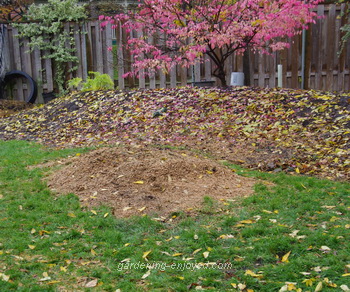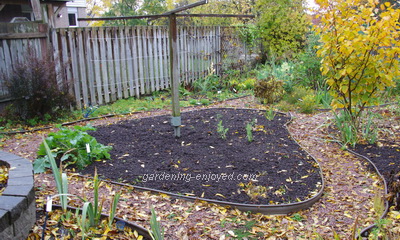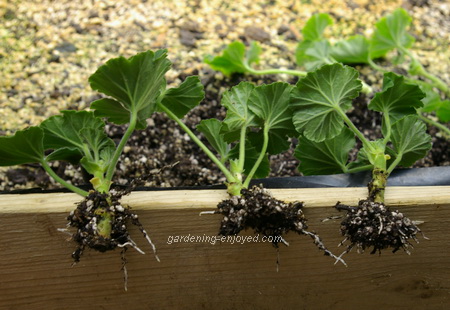
A week of wonderful warm weather and some calmness in the family allowed me to spend some much needed time in the garden this past week. The garden needed it and I needed it. Thank you to all of you who expressed concern for Matilda, she remains in hospital but is improving daily and her prognosis is very good although it will be a long journey. With my time in the garden this week its prognosis is also very good and gardening is always a long but enjoyable journey. It does have its setbacks that are beyond our control and we dealt with one of those this week. A feature of the back yard has always been a large black ash tree. A nasty creature, the Emerald Ash Borer has managed to kill this large specimen and this week the tree crew arrived and emptied my yard of its skeleton and my wallet of several dollars. It is amazing to watch these young men as they scramble up a large tree and quickly but very
carefully bring it to the ground piece by piece. Eventually there is no sign of their arrival except for a large pile if mulch that they created when they ground out the stump. This mulch will get transported to the new woodland area behind the berm and the hole will be filled in with soil and planted.
 It seems that no chore in the garden can be accomplished until some other chore is completed. It’s a grand time and space management scheme. It’s well past time to do a serious clean up of the garden. Most things that get removed from the garden go into the compost bin. The compost bin is full. The other compost bin must be emptied and spread on the parts of the garden so that the first bin can be turned over into the emptied one. It is now empty and the garden with the fresh compost looks wonderful and is ready for spring planting. I have turned the filled bin over into the empty bin and I can now start filling it with the material that I am removing from the other gardens. It’s very difficult to complete any job without finding another job that it is necessary to address. The removable doors on the front of the compost bins have finally completely rotted and new ones had to be built in order to carry on. A
trip to the lumber yard and an hour or so with a hammer and saw and then we could get back to the original chore of filling compost bins. It’s always an adventure.
It seems that no chore in the garden can be accomplished until some other chore is completed. It’s a grand time and space management scheme. It’s well past time to do a serious clean up of the garden. Most things that get removed from the garden go into the compost bin. The compost bin is full. The other compost bin must be emptied and spread on the parts of the garden so that the first bin can be turned over into the emptied one. It is now empty and the garden with the fresh compost looks wonderful and is ready for spring planting. I have turned the filled bin over into the empty bin and I can now start filling it with the material that I am removing from the other gardens. It’s very difficult to complete any job without finding another job that it is necessary to address. The removable doors on the front of the compost bins have finally completely rotted and new ones had to be built in order to carry on. A
trip to the lumber yard and an hour or so with a hammer and saw and then we could get back to the original chore of filling compost bins. It’s always an adventure.

It’s still raining and I certainly hope it clears up before the ghosts and goblins come looking for treats tonight. If not too many show up I may be forced to consume all the leftover chocolate and that would be a real hardship. I will ignore the rain and descend to the basement as soon as I have finished “Dallying” where I will find some pleasant indoor gardening. The Geraniums and Coleus in the propagating bed are well rooted and need to be potted up. Rooting them in the soilless media of that bed produces roots that are already compatible with the media that they are going to be potted into. These plants will root in plain water but they make slightly different roots using that method and they have a bit more difficulty moving into a container of potting mix. Strangely, some of my Begonias seem to root much more readily in water than they do in the propagating bed. Nature just likes to keep me confused. The
rack of lights will now be turned on to grow these cuttings into healthy plants that will eventually find their way back to the garden next spring.
Now it’s time to answer a few of my reader’s questions. Don’t forget to check the front page of the Website for frequent short ideas for current gardening activities.
Brenda Asks? Ken, how does the Cymbidum Orchid differ from the orchids that can be purchased at the grocery store? Do you have a picture of one? Sounds beautiful!
Ken Answers! Cymbidiums are usually much larger than the Phalaenopsis that are the ones usually available in the stores and in nature they are terrestrial rather than epiphytic . Check this page on my web site for pictures and more info.
Barbara Asks? Would like your thoughts of using maple leaves as fall mulch
on vegetable garden. We have lots of maple trees. We visited a veg garden this summer that had at least 10 inches of maple leaves as covering, in between rows of vegetables. Of course they had no weeds, If we cover our vegetable garden with that many leaves now, we feel we would have to remove them in early spring for the ground to warm for planting.
Ken Answers! I use a lot of Maple leaves on my veg garden. I spread them out in thick rows and then shred them with my lawn mower. That shredded material is spread evenly across the soil and I just plant through it in the spring. That planting action and the worms slowly incorporate them into the soil and in the meantime they are an effective mulch.
Ann Asks? I so enjoy your newsletter and always find your advice helpful. Do you have a “short list” of perennials to NOT cut down in the fall, not so much to leave for winter interest or to feed the birds, but more to preserve the plant (e.g.,
chrysanthemums)?
Ken Answers! My short list is often created by my procrastination rather than any intelligent approach. Tall stiff stemmed ones are left for winter interest and to feed birds but I can't really think of a list that needs to stay uncut to insure survival. If things don't survive in my garden then I replace them with something that will. I admit to being both lazy and ruthless.
Jeff Asks? Any ideas on overwintering blackberries? Last fall I burlapped, the mice moved in over winter to the nice home I created and ate the bark off the Thornless plant, and the cold erased the Thorned variety. There have been years I've done nothing special and lost nothing.
Ken Answers! I ignore my Raspberries and Blackberries, except for the required pruning and that seems to be a satisfactory treatment for the winter. I tend to be a bit of a lazy gardener
and if things cannot survive on their own they usually don't get a permanent place in my garden.
111 Trent St. W.
Whitby ON
L1N1L9

 It seems that no chore in the garden can be accomplished until some other chore is completed. It’s a grand time and space management scheme. It’s well past time to do a serious clean up of the garden. Most things that get removed from the garden go into the compost bin. The compost bin is full. The other compost bin must be emptied and spread on the parts of the garden so that the first bin can be turned over into the emptied one. It is now empty and the garden with the fresh compost looks wonderful and is ready for spring planting. I have turned the filled bin over into the empty bin and I can now start filling it with the material that I am removing from the other gardens. It’s very difficult to complete any job without finding another job that it is necessary to address. The removable doors on the front of the compost bins have finally completely rotted and new ones had to be built in order to carry on. A
trip to the lumber yard and an hour or so with a hammer and saw and then we could get back to the original chore of filling compost bins. It’s always an adventure.
It seems that no chore in the garden can be accomplished until some other chore is completed. It’s a grand time and space management scheme. It’s well past time to do a serious clean up of the garden. Most things that get removed from the garden go into the compost bin. The compost bin is full. The other compost bin must be emptied and spread on the parts of the garden so that the first bin can be turned over into the emptied one. It is now empty and the garden with the fresh compost looks wonderful and is ready for spring planting. I have turned the filled bin over into the empty bin and I can now start filling it with the material that I am removing from the other gardens. It’s very difficult to complete any job without finding another job that it is necessary to address. The removable doors on the front of the compost bins have finally completely rotted and new ones had to be built in order to carry on. A
trip to the lumber yard and an hour or so with a hammer and saw and then we could get back to the original chore of filling compost bins. It’s always an adventure.
